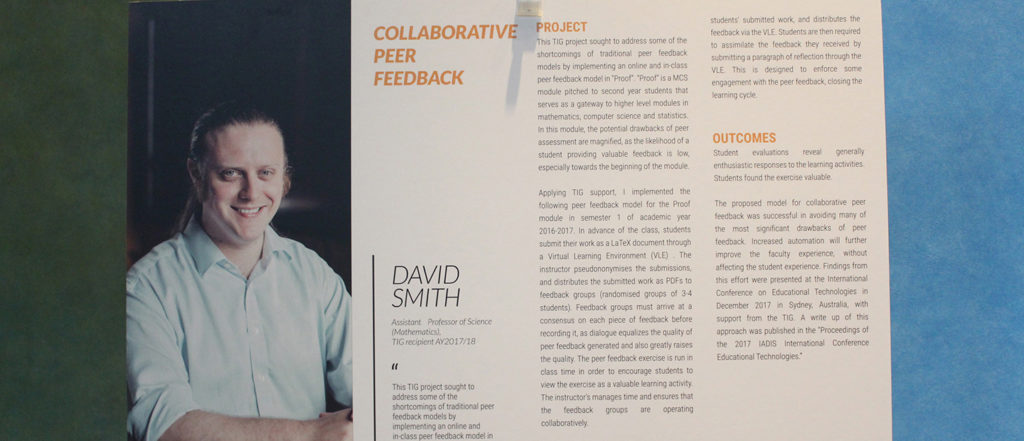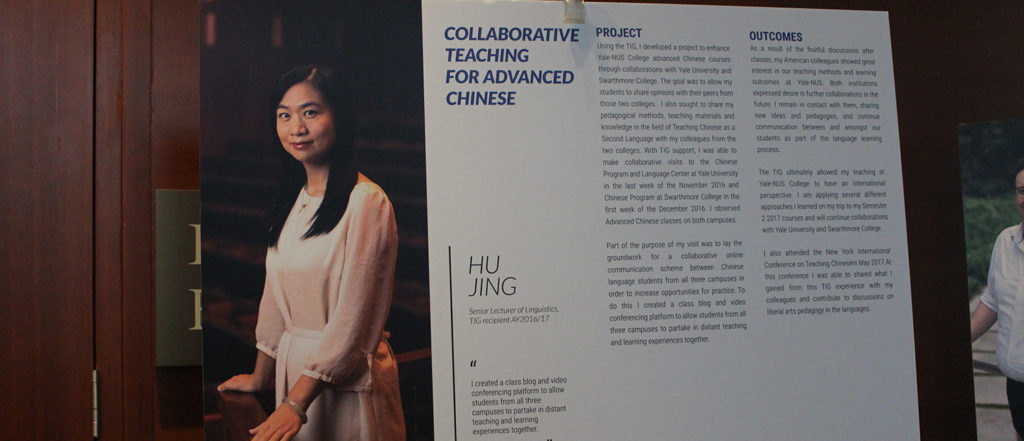Teaching Innovation Grant offers faculty members new opportunities to explore student learning

At Yale-NUS, students taking the popular Proof module have their peer feedback assigned, collected and distributed—all using automated software. Peer feedback is an important element in the course, as students often work in groups to complete mathematical proofs and give feedback on others’ proofs. Previously, instructors had to spend time assigning students to groups while respecting diversity concerns, anonymising submitted work, and assigning the submissions to be critiqued. Supported by the Teaching Innovation Grant (TIG), Assistant Professor of Science David Smith developed the software prototype to make teaching more efficient.
“It has significantly increased the amount of time I can spend on other aspects of this module, including developing more extra practice materials and giving more detailed feedback on papers and student presentations,” said Dr Smith. He also shared parts of the software online with other educators, in line with the TIG’s goal of spreading teaching innovations beyond the Yale-NUS community.
The TIG supports faculty with up to $5,000 to develop new pedagogies, acquire educational technology, develop curriculum and collaborate with other educators around the world. Supported by the Yale-NUS Educational Resources & Technology (ERT) Office, the Centre for Teaching & Learning (CTL) and the President’s Office, the TIG was first awarded in Academic Year 2016/2017. The grant has been used to develop software to teach mathematical proofs, collaborate with Yale and Swarthmore on Chinese teaching, and publish a journal of student research on Dante’s Divine Comedy, among others. On 24 January 2018, CTL organised an event to recognise the efforts of TIG recipients and showcase their pedagogical explorations and innovations.

Senior Lecturer of Humanities (Linguistics) Hu Jing used the TIG to collaborate with the Chinese departments at Swarthmore College and Yale University. In late 2016, she visited both institutions to observe their pedagogies and learned that as some students had been exposed to Chinese language while growing up, it was important to divide students into heritage and non-heritage tracks because of the significant language proficiency gap.
She shared with faculty at Yale and Swarthmore on teaching methods at Yale-NUS, such as how to edit teaching materials for students of diverse linguistic backgrounds. A class blog was created so that participating students could exchange ideas and discuss films related to Chinese culture and society. “Through this, they learn not only the language but also Chinese history and society,” said Ms Hu. Moving forward, she will continue with collaborative distant teaching and learning via video-conferences between students from the three campuses.
The TIG also supported the publication of undergraduate research under the guidance of Assistant Professor of Humanities Andrew Hui. The journal featured the final papers of six students who had taken his class on Dante’s Divine Comedy in 2015. Student editors Carmen Denia (Class of 2017) and Thu Truong (Class of 2018) revised the papers and the journal was published in October 2017.
“Whereas most final papers in class are quickly written and then summarily hidden away and forgotten, we worked on them, refined them, and made them exponentially better than any end-of-term paper,” wrote Dr Hui in the foreword. He added that the goal of the publication was to build an ‘authentic learning experience’ where contributors learnt the process of journal submission, revision, and peer review, and student editors learnt the process of running a journal.
In their foreword, the student editors said the experience was deeply transformative. “If our independent research allowed us to craft a pathway for our thoughts to come forward, editing taught us to step back and absorb the thoughts of others,” wrote Carmen and Thu.
CTL Director Dr Nancy Gleason said, “The Teaching Innovation Grant is now in its third year and we are seeing some exciting outcomes. The CTL has worked closely with ERT to make teaching efforts more visible so that others can benefit from their colleagues’ innovations. We had a successful teaching recognition dinner this January where fruitful conversations buzzed about what is working well in our classrooms. It is an exciting time to be teaching in the liberal arts in Asia and we look forward to another year of supporting our faculty members in their efforts.”
To read about the other TIG projects, click here.





